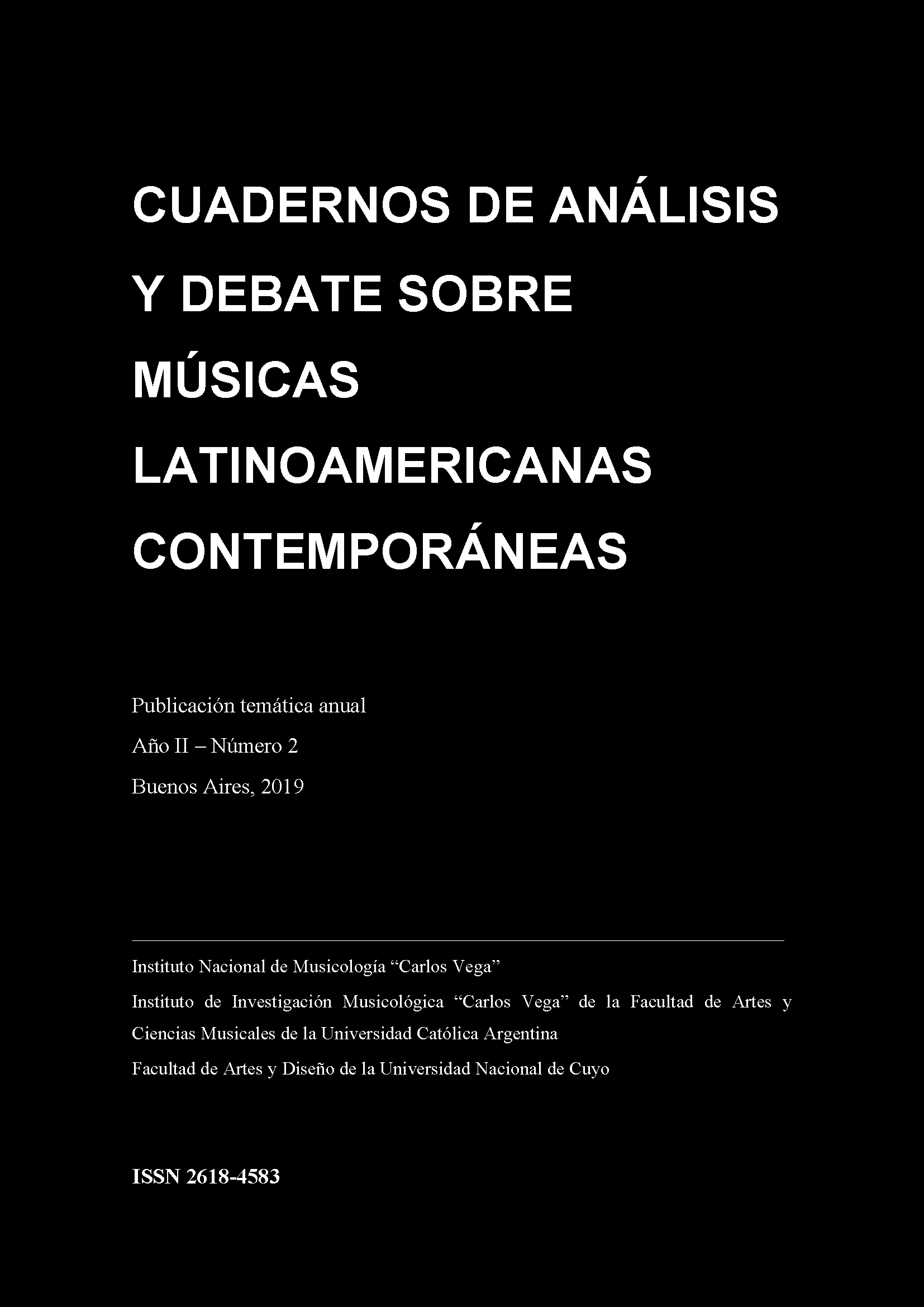Objetos sonoros de múltiples componentes y escalas con un comportamiento no-lineal
Keywords:
multidimensionality, multiscales, non-linearity, semiotic, cognitionAbstract
The writing presented here has attempted to reach an understanding regarding certain current musical objects (works by Julio Estrada and Pablo Araya primarily); that is, to understand its ontological nature. The conclusion reached is that they have a multi-component structure and scales in addition to a highly irregular and unstable dynamic behavior (non-linearity). Such a thing gives great timbral complexity. However, this has repercussions on the ways in which composers think and reason their music, an issue that entails a semiotic and cognitive problem.
Downloads
References
Araya, Pablo (2018). Objetos sonoros y configuraciones texturales dinámicas del sonido en la música instrumental contemporánea, ilacremus (perspectiva interdisciplinaria del laboratorio de creación musical UNAM), vol. 2(2), pp. 97-137.
Bartha, Paul (2013). Analogy and Analogical Reasoning, The Stanford Encyclopedia of Philosophy (spring 2019 Edition), Edward N. Zalta (ed.), Recuperado de: URL = <https://plato.stanford.edu/archives/spr2019/entries/reasoning-analogy/> [consultado por última vez el 11/04/19].
Beran, Jean (2004). Interdisciplinary statistics: statistics in musicology, Boca Raton, London, New York, Washington DC: Chapman & Hall/CRC Press Company.
Bohm, David (1988). La totalidad y el orden implicado, Barcelona, España: Kairós (4ta edición 2002).
Cilliers, Paul (1998). Complexity and Postmodernism, London_New York: Routledge (Taylor & Francis Group).
Cilliers, Paul (2001). Boundaries, Hierarchies and Networks in Complex Systems. International Journal of Innovation Management, Vol. 5, No. 2 (June), pp. 135–147.
Davies, P. y Gregersen, N.H. (eds.) (2010). Information and the Nature of Reality: from Physics toMetaphysics, UK-EEUU: Cambridge University Press.
Einstein, Albert e Infeld, Leopold (1993). La evolución de la física, Barcelona, España: Editorial Salvat, 1993.
Fraenza, Fernando (2001). Arte y comunicación en el mundo administrado. Tesis Doctoral. “Apéndice 1: Elementos primarios de teoría de los signos. Sassure, Hjemslev, Barthes y Peirce”, pp. 339-346.
Gelfert, Axel (2016). How to do science with models: a philosophical primer, Switzerland: Springer.
Haumann, Niels Trusbak (2015). An Introduction to Cognitive Musicology. DMO Danish Musicology Online Special Edition, ISSN 1904-237X, pp. 11-45.
Hofweber, Thomas (2014). Logic and Ontology, The Stanford Encyclopedia of Philosophy (Fall 2014 Edition), Edward N. Zalta (ed.), URL = https://plato.stanford.edu/archives/fall2014/entries/logicontology/ [02 de septiembre de 2017]
Lakoff, George (1993). The contemporary theory of metaphor. En Metaphor and Thought, Cambridge, UK: Cambridge University Press (Andrew Ortonyed.).
Pauli, Wolfgang (1996). Escritos sobre física y filosofía, Madrid, España: Editorial Debate S.A.
Prigogine, Ilya y Stengers, Isabelle (1990). La Nueva Alianza - Metamorfosis de la Ciencia, Madrid, España: Alianza Editorial S.A. (2da edición).
Prigogine, Ilya y Stengers, Isabelle (1994). Entre el tiempo y la eternidad, Madrid, España: Alianza Editorial S.A. (2da reimpresión).
Roederer, Juan G. (1997). Acústica y psicoacústica de la música, Bs. As., Argentina: Editorial Ricordi Americana.
Strogatz, Steven H. (1994). Nonlinear dynamic and chaos, EEUU-Canadá: Addison Wesley Publishing Company.
Tenney, James (1988). META-HODOS A Phenomenology of 20th Century Musical Materials and an Approach to the Study of Form and META Meta-Hodos, Baltimore, EEUU: Frog Peak Music (2nd edition).
Varèse, Edgar y Wen-Chung, Chou (1966). The liberation of sound. Perspectives of New Music, Vol. 5, No. 1, New York, (Autumn - Winter, 1966), pp. 11-19.
Von Bertalanffy, Ludwig (1972). The History and Status of General Systems Theory. The Academy of Management Journal, Vol. 15, N° 4, pp. 407-426.
Downloads
Published
How to Cite
Issue
Section
License
Copyright (c) 2019 Pablo Araya

This work is licensed under a Creative Commons Attribution-NonCommercial-ShareAlike 4.0 International License.







